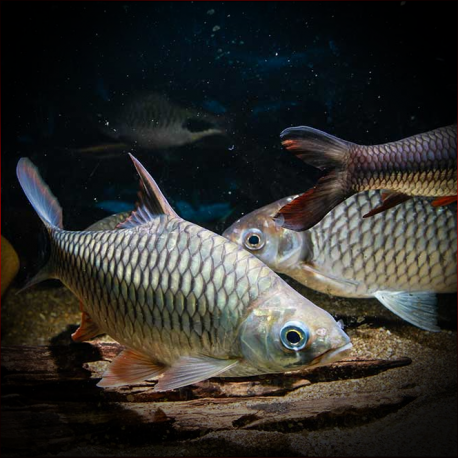More info
Datasheet
| Minimum Tank Size | 10000 litres / 2641.72 US gallons |
| Maximum Size | 50.0cm / 19.69inches |
| Temperature | 20°C / 68.00°F - 26°C / 78.80°F |
| Hardness | 2.02dgH / 36ppm - 15.02dgH / 268ppm |
| pH | 6.0-8.0 |
General Description
The Goldfin Tinfoil Barb, scientifically known as Hypsibarbus Malcolmi, features distinguishing characteristics such as 12-17 rakers on the first gill arch, 16 circumpeduncular scale rows, and a dark median portion of the dorsal fin. This species, like others in the genus Hypsibarbus, possesses two pairs of barbels, a serrated dorsal-fin spine, and scales with black margins, typically displaying extended falcate tips on its fins. Valued as food fish, Hypsibarbus species face a decline primarily due to human activities such as river damming and agricultural practices.
Aquarium Setup
Maintaining a group of half a dozen or more individuals of Hypsibarbus in a massive tank of at least 10,000 litres is recommended. The aquarium setup should mimic a flowing river, with a substrate of rocks, gravel, boulders, and driftwood. Water conditions should be carefully monitored to maintain a water hardness of 36-268ppm, a pH range of 6.0-8.0, and a temperature between 20-26°C. A well-aerated environment with high dissolved oxygen levels is crucial for their thriving.
Behaviour
Goldfin Tinfoil Barbs are not aggressive but may prey on small fish and disturb slow-moving or timid species due to their constant and vigorous feeding behavior. These schooling fish prefer to be kept in groups and thrive in a community setup with ample space for swimming. They are known to exhibit a schooling behavior and should ideally be kept with their kind or other robust tankmates.
Feeding and Diet
In the wild, Hypsibarbus species feed on organic detritus and aquatic macroinvertebrates, displaying an opportunistic foraging behavior. In aquariums, they readily accept a varied diet consisting of live and frozen foods like bloodworms, Daphnia, Artemia, along with high-quality flakes, granules, and vegetable matter. Maintaining a diverse diet is essential for their overall health and well-being.
Reproduction & Dimorphism
Information on the reproduction of Hypsibarbus Malcolmi is unreported. Sexually mature females of this species are likely to be deeper-bodied and may grow larger than males. Further details regarding their mating behavior and reproductive characteristics remain unknown.
Habitat and Distribution
Goldfin Tinfoil Barbs are prevalent in the Mekong River system across Laos, Thailand, and Cambodia. They also inhabit the Chao Phraya and Maeklong drainages in Thailand, as well as some smaller watersheds in Peninsular Malaysia. Preferring rocky habitats with flowing water, these fish show seasonal migratory patterns, moving between larger river channels during the dry season and smaller tributaries and flooded forests in wetter months. They do not readily adapt to artificial impoundments, showing a strong affinity for natural riverine environments.

